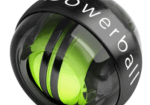Turkmen, E., Akbaba, Y., Altun, S. (2019). Effectiveness of video-based rehabilitation program on pain, functionality, and quality of life in the treatment of rotator cuff tears: A randomized controlled trial. Journal of Hand Therapy, S0894-1130(18)30396-X. DOI: https://doi.org/10.1016/j.jht.2019.08.004
The Skinny
The purpose of this article was to determine the efficacy of video-based rehabilitation programs (VBR) in the conservative treatment of partial rotator cuff tear in comparison to a physiotherapist-supervised rehabilitation program (PSR). Patients completed a 6-week rehabilitation program for rotator cuff tear (hand to shoulder rehab). The VBR group was provided with video instructions for treatment and the PSR group received in person instructions from their therapist. The results of this study showed that the VBR program was just as effective as the PSR program in treating rotator cuff tears with both groups achieving significant improvements in ROM, pain, functional status, and quality of life. The major difference between the two groups was that that the PSR group had higher patient satisfaction ratings highlighting the importance of therapist client interaction.

In The Weeds
The study was a randomized control trial with 30 participants who were randomly assigned to the video-based rehabilitation group (VBR) or the physiotherapist-supervised rehabilitation group (PSR). Active shoulder range of motion, pain, functional status, patient satisfaction, and health-related quality of life of the patients were assessed before and after treatment. Participants were 40 years of age or older and were diagnosed with a unilateral partial supraspinatus muscle tear by an orthopedic surgeon via MRI evaluation.
Both groups were provided with a similar progressive treatment program. The VBR group had an in-person evaluation every 15 days in which they would proceed with the video-based intervention at the clinic. This was done so researchers could monitor the condition of the patients, accuracy of the exercises given, and the clarity of the commands, but feedback was withheld so as not to interfere with the research outcomes and the effectiveness of the video-based program.
Researchers used goniometer measurements (ROM), visual analog scale (pain), DASH questionnaire (functional performance), short form 12 (quality of life), and the Global Rating of Change scale (satisfaction) as outcome measurement tools.
Researchers found significant improvements in all outcome areas with no significant difference between the two groups. The results of this study support the efficacy of video-based interventions for the treatment and management of partial rotator cuff tear.
Bringing It Home
Telehealth is slowly becoming a viable option for therapists and their patients as technology improves and reimbursement standards change. This study supports the use and effectiveness of video-based interventions; however, one major limitation of this study is the generalizability to clients.
Forty-five patients were initially considered for this study, and 12 did not meet the inclusion criteria. The study does not specifically state why these 12 participants were excluded, and the video-based intervention may have been inappropriate. The advantage of video-based interventions includes ease of access for patients, but it may be difficult to tailor video-based interventions to each patient’s specific client factors and performance capacity. The value of video-based interventions may be better used as a supplement to regular therapy rather than an alternative which I believe was the true intent of this article. All in all, this article was well done and provides evidence to support the use of video-based interventions in therapy.
1 Comment
Leave a Comment
More To Read
Carpal tunnel syndrome and its association with body mass index, wrist ratio, wrist to palm ratio, and shape index
A literature review of carpal tunnel syndrome and its association with body mass index, wrist ratio, wrist to palm ratio, and shape index Madani, A. M., Gari, B. S., Zahrani, E. M. A., Al-Jamea, L. H., & Woodman, A. (2022). A literature review of carpal tunnel syndrome and its association with body mass index, wrist…
Read MoreWrist Proprioception Ideas for Hand Therapy
Wrist Proprioception Intervention Ideas: By Ammie Ingwaldson Lack of wrist proprioception exercises can affect clients in the hand therapy setting with neurological and musculoskeletal conditions. Proprioception limitations are found in common conditions such as carpal tunnel syndrome, distal radius fracture, and CRPS (Valdes, Naughton & Algar, 2014). Proprioception is necessary during daily tasks to provide…
Read MoreWhat is the Effectiveness of IASTM?
Citation Kim, J., Sung, D. J., Lee, J. (2017). Therapeutic effectiveness of instrument-assisted soft tissue mobilization for soft tissue injury: Mechanisms and practical application. Journal of Exercise Rehabilitation, 13(1). doi: https://doi.org/10.12965/jer.1732824.412 The skinny IASTM is a relatively simple technique that uses the surface of an instrument to minimize the amount of pressure or force needed…
Read MoreTest for Distal Radial Ulnar Joint of the Wrist
Ballottment Test for Wrist DRUJ Reliability and Validity Analysis of the Distal Radioulnar Joint Ballottement Test Nagashima, M., Omokawa, S., Hasegawa, H., Nakanishi, Y., Kawamura, K., & Tanaka, Y. (2024). Reliability and validity analysis of the distal radioulnar joint ballottement test. The Journal of Hand Surgery, 49(1), 15–22. https://doi.org/10.1016/j.jhsa.2023.10.006 The Skinny: Distal radioulnar joint (DRUJ)…
Read MoreSign-up to Get Updates Straight to Your Inbox!
Sign up with us and we will send you regular blog posts on everything hand therapy, notices every time we upload new videos and tutorials, along with handout, protocols, and other useful information.







Thank you for this helpful article.